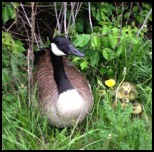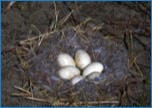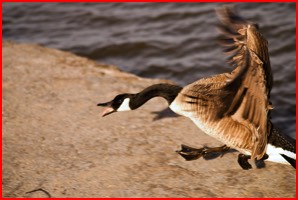Information and Resources about Canada Geese
Read about the growing problem of Geese in Ohio - and see the GooseBuster featured here in the Dayton Daily News!

Canada geese are large majestic birds.
This water bird, weighing up to twenty-four pounds and twenty-two to forty-eight inches in length, is probably the most populated water bird in North America.
The male and female look very similar and the only way to visually tell them apart is by their size. The male is slightly larger than his mate.
With a wing span of greater than six feet, they can fly very fast. Cruising speeds are about thirty miles per hours, speed during migration is about forty miles per hour, and if they are in a hurry to get somewhere, they can fly as fast as sixty miles per hour.
Canada geese eat plants, marsh grasses, berries, salt grasses, clover, cattails, pond weeds, and in the fall will forage in corn fields for kernels of corn that were missed at harvest.
Goose History in Ohio
Canada geese were reportedly extirpated from Ohio between the end of the Civil War and the turn of the century. The Ohio Division of Wildlife initiated a giant Canada goose restoration program with 10 pairs each on three state-owned wetland areas in 1956. Goose population surveys were conducted annually on the three goose management areas since the start of the program; however, the first statewide survey was not conducted until 1979.
At that time, Canada geese were nesting in 49 of Ohio’s 88 counties with a state population of 18,000 geese. Recent surveys have found goose nests in every county with a population estimate of 84,000 geese, thus this quickly expanding goose population has caused conflicts with our growing human population.
Canada geese were reportedly extirpated from Ohio between the end of the Civil War and the turn of the century. The Ohio Division of Wildlife initiated a giant Canada goose restoration program with 10 pairs each on three state-owned wetland areas in 1956. Goose population surveys were conducted annually on the three goose management areas since the start of the program; however, the first statewide survey was not conducted until 1979.
At that time, Canada geese were nesting in 49 of Ohio’s 88 counties with a state population of 18,000 geese. Recent surveys have found goose nests in every county with a population estimate of 84,000 geese, thus this quickly expanding goose population has caused conflicts with our growing human population.

The cream-colored eggs are laid in March or April and hatch twenty-five to thirty days later. Within twenty-four hours of hatching the goslings (baby geese) are swimming in the water.
If there are several families of geese living in the same area, they will get together to form a creche and as a group take care of the goslings.
During incubation the adults molt (lose their flight feathers) and aren't able to fly. The feathers grow back in plenty of time for fall migration. When they get their flight feathers back the parents will teach their young to fly.

Because of the large population of geese they will sometimes invade public places such as parks and golf courses to find food and shelter.
Sometimes Canada geese can make pests of themselves. If living near public swimming places their feces, which contain e-coli, can pollute the water and make the water unsuitable for swimming. If high goose numbers exist in shallow waters, their droppings can change the water’s ecology and cause bacterial and algae problems.
Geese are territorial birds and will not hesitate to protect their nest and eggs from anyone they see as a threat. An aggressive adult goose can easily knock down a child or senior citizen, and geese can fly up to 50 mph. An aggressive goose will hiss at you and rear its head and then perhaps charge. Geese will fly up and can hit a human in the face. This is especially likely if the goose has nested in a place near human traffic, including a parking lot or shrubbery near a building.

